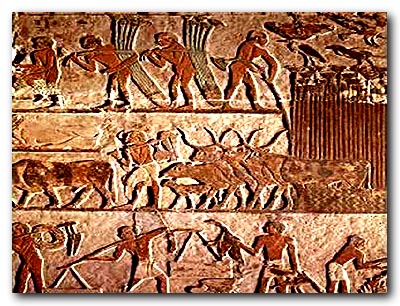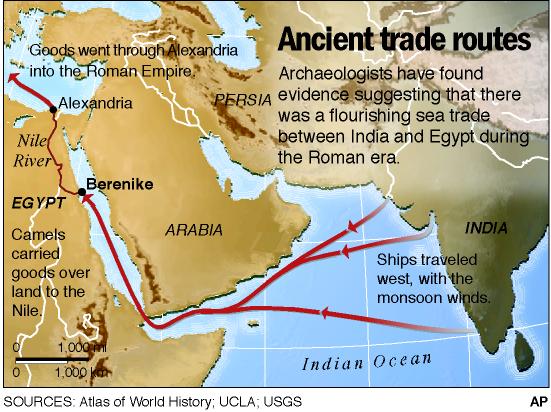Rise of Civilization
Return to the Home Page | Ancient Warfare | Ancient Cultures

The rise of civilization
Civilizations rose and fell time and again, in different places at different times, some lasting much longer than others. There were at least two great dark ages during which civilization essentially disappeared from most of the world (1200 BC to 700 BC and 400 AD to 900 AD). The two prerequisites for civilization were the human ability to organize and the production of food in large quantities. Large amounts of food made large populations possible, but only if they could be effectively organized.In the space of 5000 years, from 8000 BC to 3000 BC, the earliest settled villages grew into full civilizations in the Middle East, Anatolia, Iran, India and Pakistan, and China.
Among the important steps in the movement toward civilization were irrigation, the city-state, trade, metalworking, and writing.
Irrigation
It is not accident that the cradles of civilization were river valleys such as the Nile, Tigris, Euphrates, Indus, and Yellow. The land around these rivers must have been recognized as being rich, but the source of their richness was new soil deposited each year when the rivers flooded. The valleys were not useful to the earliest farmers until they learned to control flooding or adapt to it. The rise of civilization was partly the story of learning to control these rivers and realizing the potential of the land.More is known about the history of the Tigris, Euphrates, and Nile civilizations than others because these areas have been extensively excavated. These three rivers carry water from highlands far inland to the sea, passing through very arid regions. The contrast between the land adjacent to the river and that a short distance away is striking. Desert can exist only a few hundred yards from the Nile. The land around the rivers is rich, but making it bloom required the transfer of water to those parts of the valley not adjacent to the river.The construction of large-scale irrigation projects required a large communal effort and organization. The fact that the irrigation was accomplished is proof that governments and organization were in place, although it was accomplished before writing appears. Once irrigation was understood and in place, food production soared along the rivers, making these valleys the richest and most populous places on Earth.The relative riches of the area made possible specialization of labor, leisure time, the development of the arts, and the necessity of defense.

The City-state
The Tigris and Euphrates Rivers of the Fertile Crescent flood in the summer, during the growing season. For the land in this area to be cultivated, the rivers had to be held in check by dikes and canals. Nothing came easy in Mesopotamia. There were few natural resources other than farmland. The building material was mud. To be successful, the people living there had to be resourceful. It is no accident that many of the great technological innovations of the era, such as invention of the wheel, occurred here. From 5000 BC to 3000 BC the plains through which these two rivers flowed became covered with settlements. Larger settlements in the area were separated first physically by the shifting of the rivers and areas of marshland and then politically.By 3500 BC the people at the mouth of the river, the Sumerians, had achieved the first full civilization. Their major city was Ur, situated on a lagoon of the Persian Gulf where it supplemented its farming by operating as a trading post for both sea and river traffic. Royal burials from Ur, dated to 2600 BC, revealed remarkable treasures, including bowls of gold inscribed with the prince’s name, an elaborate helmet beaten from a sheet of gold, axes of electrum and a dagger of gold (weapons for decorative purposes only), and many more bowls of gold, silver, and copper. Some of the royal tombs included large supplementary burials of assistants and retainers apparently included to help the deceased in an afterlife. These tombs were evidence of prominent social status.The first Sumerian king who stands out in history is Ur-Nammu, who built the great ziggurat of Ur. This enormous mud brick structure was restored by later kings in the area over the years and still exists. Massive walls were built to defend Ur, but these were torn down by the Elamites who captured the city around 2000 BC.The city-state was the typical political organization in the Middle East and Eastern Mediterranean until almost the end of antiquity. They were often collected into an empire, but these rarely held together for long until the Romans appeared. Egypt was the major exception to the city-state, but its isolated situation made it unique.

Trade
Trade on a large scale was financed by agricultural surpluses that became available especially after the river valleys were irrigated and organized. The trade of surpluses greatly encouraged the specialization of crafts. People near important raw materials could concentrate on a craft and trade the result of their labor for food from the river valleys. People in the mountains around Ur traded metal tools and ore for food, for example. The placement of the first civilizations on rivers and coasts accelerated trade because transport by boat was cheap. Pottery could be shipped by boat over long distances. The cedar of Lebanon could be shipped by sea to Egypt, where timber was in short supply.Trade was an economic multiplier. The comparative advantages of production in different areas meant that all participants were better off after trading.Trade was also an important disseminator of ideas. Visitors to other cultures spread new ideas and innovations quickly. Those cultures that actively traded were usually among the most advanced.

Metalworking
The earliest use of metal yet known comes from southern Turkey, north of Syria. Hammered copper objects found here date to 7000 BC. Prolonged hammering causes metal to eventually harden and become brittle, leaving it useless. The process of annealing, heating the metal in a fire, restores its malleability, making it useful again. The process of annealing seems to have been discovered very early.The first important breakthrough in metallurgy was the discovery of smelting, the process of extracting metals from ore under high temperatures. This greatly expanded the use of copper because ore was much more common than raw copper that could be hammered. By 4000 BC small, simple copper objects were widespread in the Middle East.The second important breakthrough in metallurgy was the discovery of bronze around 3000 BC. This copper and tin alloy was harder than copper and more useful for tools, and it also flowed more easily when molten than copper did and was easier to cast.Metalworking in Thailand goes back to 4000 BC and bronze appears there before 2000 BC. Metal working appeared in the Andes of South America around 2000 BC. This development is considered to be independent of metalworking in the Middle East.Iron was known from the third millennium BC, but it was not mastered until many years later. Some of the earliest iron artifacts were made from meteoric iron. Ancient trading records show that iron was more valuable than silver during much of the second millennium. One of two ceremonial daggers placed in the tomb of Tutankhamen in 1323 BC is made of iron (the second is gold). The use of iron spread after 1200 BC during the first dark age, in part perhaps because the breakdown of trade limited supplies of copper and tin. Without those critical metals, smiths made do with the more common iron ore, learned how to make it well, and ended up with a more useful and cheaper metal for their trouble.
Writing
It appears that writing was invented to keep accounts in trade and for the early city-states.The invention of writing took place in Mesopotamia just before the start of the Bronze Age in 3000 BC. The earliest writing was pictographic—each picture represented an object. For example, a drawing of a horse’s head represented a horse. The common writing material in Mesopotamia was a clay tablet. The preservation of large numbers of tablets allowed historians to trace the transformation of the early pictographs into cuneiform. In this system, the pictographs were gradually stylized into clusters of wedges pressed into the clay by a writing instrument called a stylus. Because clay tablets were much more likely to be preserved than more perishable media, we generally know more about those cultures that wrote in cuneiform.Writing in several forms appeared in Egypt very quickly after 3000 BC, probably influenced in function by developments in Mesopotamia. The most famous Egyptian writing was hieroglyphics, another pictograph writing especially used for temples carvings. Cursive hieroglyphics were easier to write and were used on papyrus documents and in everyday use.An important step in writing flexibility was the invention of an alphabet where letter symbols represented mouth sounds, not objects. A combination of sounds created words. The earliest alphabetic system appeared in the city of Ugarit in modern Syria around 1350 BC. Ugarit was an important trading center between Mesopotamia, Palestine, Anatolia, and the ports on the Levant leading to Greece and Egypt. The best-known script from this time is called Ugaritic, which has a 32-letter alphabet and is probably the ancestor of all later alphabetic scripts.
Return to the Home Page | Ancient Warfare | Ancient Cultures
Human Evolution | Technology:the development and use of tools | Prehistoric Human Communities |
Agriculturual Revolution | First Cities | Trade & Religon | Boats and Sea Travel



